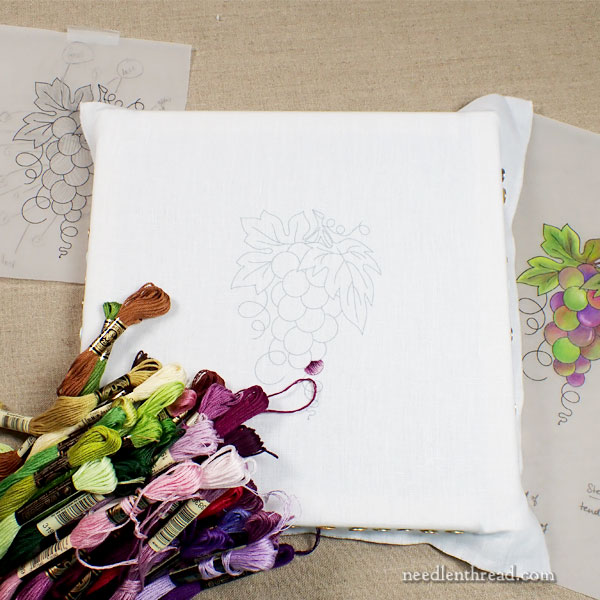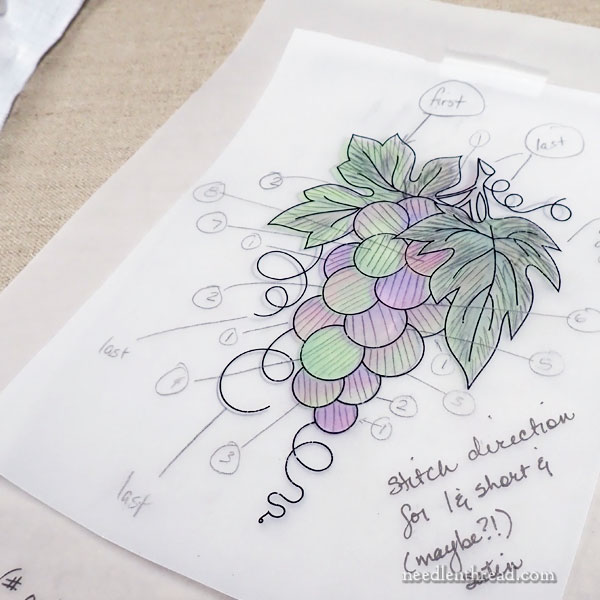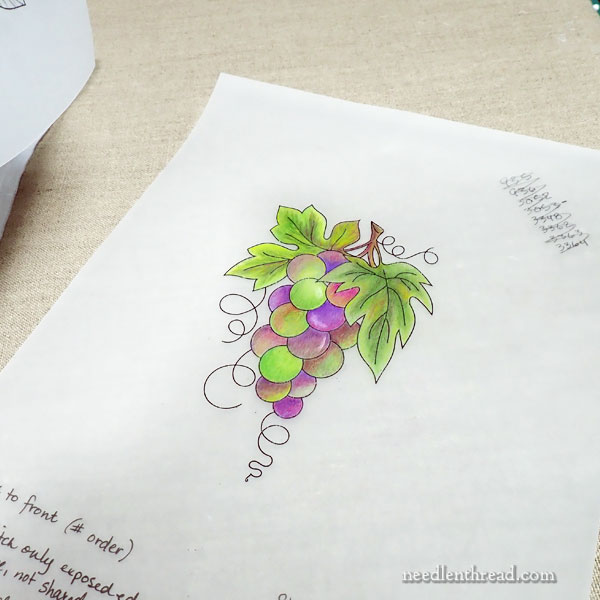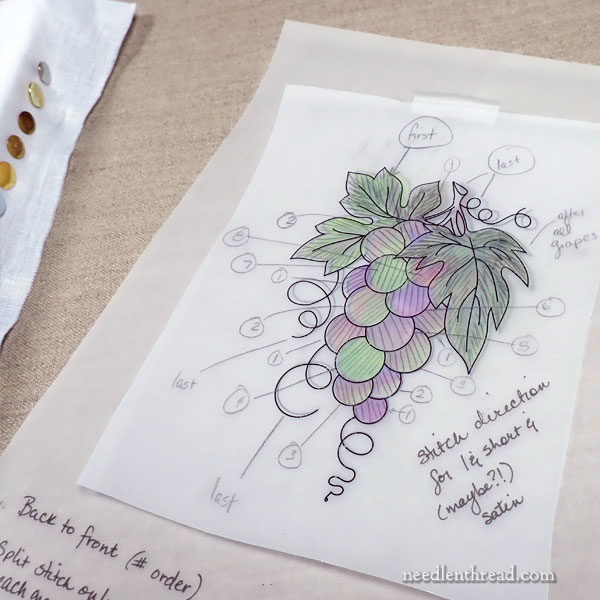A couple weeks ago, I sneak-peeked the colors for the next embroidery project in the How to Embroider (Blank) tutorials and asked you to guess what we’d be stitching.
Many of you chimed in with irises and other flowers, some chimed in with fruit, and, in fact, it’s grapes!
This is definitely a project we will feel our way feel our way through together, slowly. It’s going to be a little more complicated and challenging than the projects so far. But it’ll be fun, and, taken slowly, it’s definitely manageable.

Unlike the previous tutorials, we’re not ahead on this one on my end of things. By the time I started writing out the wheat tutorials and then the strawberry tutorials, for example, we were halfway through the embroidery on those projects. We had set color lists. We knew exactly what stitches were coming up next. We had trouble-shooted (trouble shot?) our way through a couple ideas.
By the time I wrote the daisies, the project was finished.
(You can find all of these projects listed here in the How to Embroider (Blank) series index.)
But it’s not all fun and stitching in the studio – and we can’t focused on this series alone, because I have other projects that must get done. So we aren’t too far ahead on the grapes.
In fact, we’re not ahead at all, really!
I’ve got the design finished (but untested); I’ve transferred it to two pieces of fabric – one for me, one for Anna, so that we can try different approaches; we’ve pulled temporary color palettes; and we’ve set up the projects on embroidery frames.
We’ve only put a few tentative stitches in, discussing ideas for approaching the design in ways that are instructional and accessible, and that yield satisfaction results.

Before we really delved into the stitching, so we could see where we’re going and how we might get there, we printed out the finished line drawing of the design on several pieces of craft vellum (a semi-transparent paper) to play with color and stitching ideas.
Using the vellum, we can layer over different renditions of the design, whether colored or black and white or simply plain line drawings.
This helped us establish a color guide and a stitch guide that might make sense, that can guide both of us in a similar direction. I keep saying “might” because ideas evolve and morph a bit when you’re actually stitching!
So, on the paper above, I’ve got notes on stitch direction and on order of stitching, based on the assumption that I’ll be working the design as a needlepainting project, in long and short stitch primarily.
On the other version, Anna will be testing some other approaches to stitching grapes, so that her version will probably end up a conglomeration of approaches to demonstrate other ideas. Hopefully, we’ll have a similar color layout so that the designs look related.

I like to use Prismacolors to work out color on a design. Prismacolors are wonderful colored pencils that allow for blending layers of color. If my thoughts are leaning towards shading, they’re a great way to lay out some color ideas.
Normally, I don’t like doing this color part on the printed craft vellum. Usually, the color bits (when there are color bits) materialize when I’m first doodling a design, in a sketch book or similar. But for this, I really wanted to be able to take some copious notes and do a few idea overlays with the vellum.
Will the embroidery end up looking like the colored version above? Nope, not likely. But it’s a starting point!

You can see more clearly in the photo above that the top layer is the design printed on craft vellum, trimmed, and then taped over the colored version. I took notes on both layers, concentrating on colors on the first layer, and on stitch direction and order of stitching on the second.
I find that this approach helps when contemplating shading with lots of color, especially with a more complex design that has many individual elements in it.
All the numbers scattered all over the page act as a reminder to work back to front. Anything numbered 1, for example, should be stitched before any of the surrounding elements that might overlap it.
So that’s the beginning process on this project.
Project Timing
This project will develop slowly. I’ll try to get something out each week on it, but we’ll just have to see how it goes.
We’ve been rather swamped with other stitching (for projects we need to do to be able to pay the bills!) and with other non-stitching work, like preparing kits, cutting gargantuan amounts of fabric, and so forth. Lots of good things coming up for you!
As usual, as this project comes together into specific tutorials that will be published here, those tutorials will also be available to download as PDFs for members on Patreon, where PDFs for all the previous projects in the series (wheat, strawberries, daisies) are available already.
A Note on Prismacolors
Prismacolors come in many different sized collections. I started with a small set ages ago, and expanded over time as I grew to appreciate them more.
They have a nice 72-color set bundled with an eraser available on Amazon – it’s listed on my Amazon Recommendations page under tools & accessories. It’s a pretty good price.
Another good way to purchase them is with a 40% off coupon at stores like Hobby Lobby. That’s one of the better deals for purchasing them, but it really depends on whether they have any decent sets in stock.
If you like to design your own pieces, a good set of colored pencils will be your friend, and these are among the easiest to use for shaded coloring.
And while I also use watercolor pencils, watercolor paints, and so forth, I turn Prismacolors most frequently, because they are such an easy medium to control.
This article contains an affiliate link to my Amazon Recommendations page, which means that purchased made through that link result in a small commission for Needle ‘n Thread at no extra expense to you. Thanks!